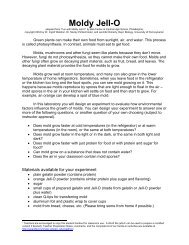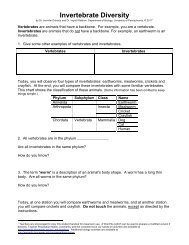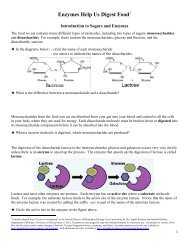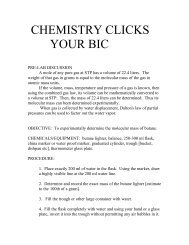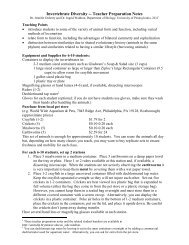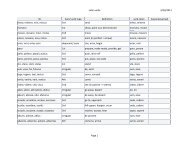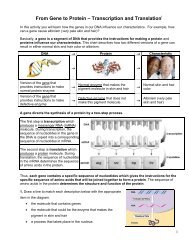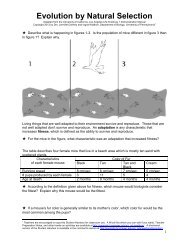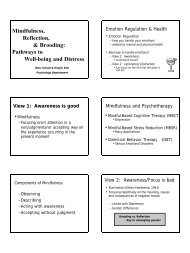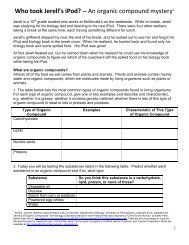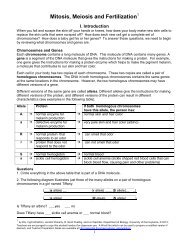Alcoholic Fermentation in Yeast - Serendip
Alcoholic Fermentation in Yeast - Serendip
Alcoholic Fermentation in Yeast - Serendip
You also want an ePaper? Increase the reach of your titles
YUMPU automatically turns print PDFs into web optimized ePapers that Google loves.
<strong>Alcoholic</strong> <strong>Fermentation</strong> <strong>in</strong> <strong>Yeast</strong>Adapted from “<strong>Alcoholic</strong> <strong>Fermentation</strong> <strong>in</strong> <strong>Yeast</strong> Investigation” <strong>in</strong> the School District of Philadelphia Biology Core Curriculum© 2011 by Drs. Jennifer Doherty and Ingrid Waldron, University of Pennsylvania Biology Department 1All liv<strong>in</strong>g cells, <strong>in</strong>clud<strong>in</strong>g the cells <strong>in</strong> your body and the cells <strong>in</strong> yeast, need energy forcellular processes such as pump<strong>in</strong>g molecules <strong>in</strong>to or out of the cell or synthesiz<strong>in</strong>gneeded molecules. ATP is a special molecule which provides energy <strong>in</strong> a form thatcells can use for cellular processes. Each cell <strong>in</strong> our body and each yeast cell can usethe energy stored <strong>in</strong> organic molecules <strong>in</strong> food to make ATP.When O 2 is available, cells use aerobic cellular respiration to transfer energy from theorganic molecules <strong>in</strong> food to ATP. As shown <strong>in</strong> the figure, aerobic cellular respiration isa complex process that beg<strong>in</strong>s with glycolysis, followed by the Krebs cycle and theelectron transport cha<strong>in</strong>. Aerobic cellular respiration can make up to 29 molecules ofATP per molecule of glucose. Most of this ATP is produced by the electron transportcha<strong>in</strong> which can only function if O 2 is available.(Figure revised from Johnson and Raven, 2004, Biology, Holt R<strong>in</strong>ehart and W<strong>in</strong>ston, p. 110)When O 2 is not available, cells can make ATP us<strong>in</strong>g glycolysis followed byfermentation. Glycolysis produces 2 ATP and fermentation restores moleculesneeded for glycolysis to cont<strong>in</strong>ue. Glycolysis followed by fermentation produces muchless ATP than aerobic cellular respiration, but fermentation is very useful when O 2 is notavailable.In the figure, fermentation is referred to as anaerobic processes. The "an" <strong>in</strong> front ofaerobic means "not aerobic". There are two types of anaerobic fermentation:• lactate fermentation (e.g. <strong>in</strong> muscles when an animal exercises hard)• alcoholic fermentation (e.g. <strong>in</strong> yeast, which can be used to make w<strong>in</strong>e or beer)★ Use the terms carbon dioxide and oxygen to complete the follow<strong>in</strong>g equation todescribe aerobic respiration.Glucose + _________________________ __________________________ + Water1 Teachers are encouraged to copy this student handout for classroom use. A Word file (which can be used to prepare a modifiedversion if desired), Teacher Preparation Notes, comments, and other hands-on activities are available athttp://serendip.brynmawr.edu/sci_edu/waldron/. Additional biology activities are available athttp://serendip.brynmawr.edu/exchange/bioactivities1
Experiment I - Effects of Sucrose Concentration on the Rate of <strong>Alcoholic</strong><strong>Fermentation</strong> <strong>in</strong> <strong>Yeast</strong>1. Humans use yeast every day to make bread, w<strong>in</strong>e and beer. What is yeast?If you want to make your own bread, you can buy yeast <strong>in</strong> the grocery store. This yeastconsists of little brown gra<strong>in</strong>s. The little brown gra<strong>in</strong>s of yeast may not seem to be alive, but ifyou put them <strong>in</strong> water with sugar, the yeast will take up the sugar and use the energy stored <strong>in</strong>the sugar molecules to make ATP and carry out the processes of life.2. What is sucrose?<strong>Yeast</strong> can convert sucrose <strong>in</strong>to glucose and use the glucose to provide the energy to makeATP.3. In your experiment, you will grow yeast <strong>in</strong> a test tube filled with water and sealed with aballoon. Do you th<strong>in</strong>k these growth conditions are aerobic or anaerobic?Under anaerobic conditions, yeast carries out glycolysis to produce ATP, followed by alcoholicfermentation which produces _________________ and ____________________.To measure the rate of alcoholic fermentation <strong>in</strong> yeast, you can measure the amount of CO 2 gasthe yeast produces. CO 2 production can be measured by measur<strong>in</strong>g the depth of the layer ofbubbles trapped <strong>in</strong> foam on top of the yeast solution and also by observ<strong>in</strong>g the balloons, whichget bigger as they catch the CO 2 produced by the yeast.4. To test whether the concentration of sucrose affects the rate of alcoholic fermentation <strong>in</strong>yeast, you will measure the rate of CO 2 production for 4 different concentrations of sucrose.Complete the table to predict how much CO 2 production you expect <strong>in</strong> each case.Sucrose ConcentrationPredicted Amount of CO 2 Production(e.g. a little, none, the most,less than..., more than..., the same as...)0% (pla<strong>in</strong> water)1% sucrose5% sucrose10% sucrose4. What will be the <strong>in</strong>dependent variable <strong>in</strong> your experiment?What will be the dependent variable <strong>in</strong> your experiment?5. What will be the control treatment <strong>in</strong> your experiment?What is the purpose of this control treatment?2
6. The procedure to measure alcoholic fermentation is:1) Label each test tube, 0%, 1%, 5%, or 10%.2) Add 10 mL of the appropriate water or sucrose solution to each tube.3) For each tube, add 0.5 mL or 1/8 tsp of yeast and put a balloon firmly over the top.4) With your thumb seal<strong>in</strong>g the top, shake each tube until the yeast is dissolved.5) Measure the depth of bubbles produced and observe the balloons as soon as the testtubes are prepared and after 10 m<strong>in</strong>utes and 20 m<strong>in</strong>utes.7. Record your observations <strong>in</strong> these data tables.Sucrose ConcentrationDepth of CO 2 bubbles at:0 m<strong>in</strong>utes 10 m<strong>in</strong>utes 20 m<strong>in</strong>utes0% (pla<strong>in</strong> water)1% sucrose5% sucrose10% sucroseSucrose ConcentrationBalloon Description0 m<strong>in</strong>utes 10 m<strong>in</strong>utes 20 m<strong>in</strong>utes0% (pla<strong>in</strong> water)1% sucrose5% sucrose10% sucrose8. While you're wait<strong>in</strong>g for the 10 m<strong>in</strong>ute and 20 m<strong>in</strong>ute data collections, complete the questionbelow and the two questions on the top of the next page.★ Use the <strong>in</strong>formation from page 1 to complete the figures below. Fill <strong>in</strong> the ovals with theappropriate molecule. On the blank l<strong>in</strong>es write the name of the appropriate process. In theboxes at the bottom of the figure write how much ATP is made <strong>in</strong> each pathway.3
8. Create a data table or tables.9. Perform your experiment and record your data.10. Did the yeast produce different amounts of CO 2 with your different treatments? Do theresults match your hypothesis?11. What do your results mean for people who make bread us<strong>in</strong>g the <strong>in</strong>gredient ortemperatures you <strong>in</strong>vestigated?If you have used clean test tubes, <strong>in</strong>gredients and mix<strong>in</strong>g procedures, you can use the yeastsolution <strong>in</strong> one of your treatment test tubes to produce a small loaf of bread. Your teacher willgive you <strong>in</strong>structions on how to add flour and water to your yeast solution and knead a breadball. Make sure you label your bak<strong>in</strong>g cup with your name so you know which is yours when itcomes out of the oven.6



